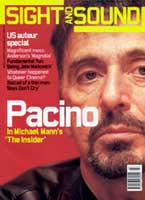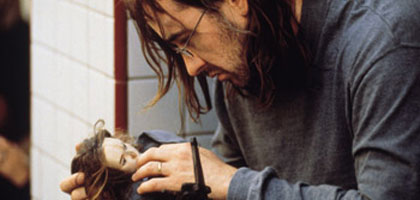
Being John Malkovich
USA 1999

Reviewed by Jonathan Romney
Synopsis
Our synopses give away the plot in full, including surprise twists.
Manhattan, the present. Under pressure from his wife Lotte, street-puppeteer Craig Schwartz takes a job as a clerk with LesterCorp., run by Doctor Lester, a company located on the low-ceilinged seventh-and-a-half floor of an office tower. He falls in love with his co-worker Maxine. Craig discovers a hidden door leading to a passage which sucks him into the head of actor John Malkovich, whose life he experiences for 15 minutes before being ejected on to the side of the New Jersey Turnpike. Craig introduces Lotte to being John Malkovich, and while she is inside him, she/Malkovich makes love to Maxine; the two women fall in love, but can only enjoy each other physically when Lotte is in Malkovich.
Craig and Maxine start a business charging people to be Malkovich. Eventually Malkovich rumbles their scam and enters his portal himself, discovering a world where everyone is him. Craig and Lotte struggle for possession of Maxine. Eventually, Craig uses his puppeteering skills to enter Malkovich permanently and turns Malkovich into a world-famous puppeteer; Maxine becomes his lover. Lester explains to Lotte that Malkovich is the latest in a line of conduits used by a secret society to enjoy eternal life in new bodies. Craig is forced out of Malkovich. Years later, Malkovich has joined the channellers; Lotte and Maxine are a happy couple with a daughter; Craig is inside their daughter, still in love with Maxine, now his mother.
Review
There's a current running joke about Being John Malkovich that speculates on what the film might have been if its star and ostensible subject hadn't agreed to play along: what, in other words, if Spike Jonze had to settle for Being Jeremy Irons? Charles Dance? Julian Sands? You can only imagine that Malkovich agreed out of a sort of inverse vanity: "Be mean to Malkovich," he apparently urged the film-makers. It's not unusual for actors to dismantle their own image on screen, but in most cases, they have the safety net of fiction. What's remarkable here is that Malkovich agreed to supply his name, face and presence, and then to have all three subverted in a manner that is anything but gently well-meaning. The film makes rich capital out of Malkovich's peculiar public image, yet this is just the tip of the iceberg. The most eccentric US debut feature in recent memory - for both Jonze and screenwriter Charlie Kaufman - is at once a Dada screwball comedy; an inquiry into the nature of personality; a metaphysical conspiracy story; and a comment on the way we invest our own desires into public figures, hollowing them out into blank receptacles.
The film's jibing at Malkovich is certainly its most approachable aspect. In recent years, his career choices have been far stranger than anything the film imagines, from high-art foreign-language roles for Raúl Ruiz and Manoel de Oliveira, to the barmy and often lazy overplaying in commercial fare such as Rounders. But here Malkovich may have found his greatest role, playing himself, or a vain, lasciviously suave caricature of himself, lounging in his penthouse with a copy of Chekhov, or attempting to lure a lover with a murmured, "Shall we to the boudoir?" Malkovich's air of narcissism is such that it comes as no surprise when, as the film puts it, he goes "up his own portal" - into a screen actor's poetic-justice nightmare world in which everyone has the face of Malkovich.
The film is partly about the empty nature of modern fame: people know your face and name, but not what you've done. No one can think of a Malkovich film, except the one in which he played a jewel thief (but there's no such film, he protests). He becomes literally a locus for other people's dreams. People inhabit him for a while: one man learns what it is like to be Malkovich ordering towels by phone. Lotte and Maxine use him as a sort of prosthetic love attachment, an animated trysting place; Craig sees him as "a really expensive suit that I enjoy wearing." In this sense, the film is an extended joke about the contemporary dreams of vicariousness and virtuality: the actor's body becomes a living version of the eXistenZ computer game devised by David Cronenberg. (Alternatively, you could see the film as a rewrite of the sci-fi topos of dimension travel: a celebrity-culture Stargate.) But the process works both ways: Craig gets to inhabit the actor and achieve his dreams, by making Malkovich the star puppeteer he could never be. They're made for each other, the actor's pretensions easily matched by Craig's delusions of profundity. But it's Malkovich who reaps the rewards of fame and a new existence, while Craig remains anonymous and in the cold.
But the film constantly shifts too much for us to pin it down: it can't easily be tagged as screwball or surreal, as a paranoid fantasy or a media satire. It's forever slipping into sideshows and diversions, from a lunatic corporate video to a hallucinatory sequence inside a chimp's memory. Nor is it in any way a typical video-maker's movie (Jonze won his spurs directing for the Beastie Boys and Björk et al), but a visually low-key, formally sober film that above all values shifts of tone and a very concrete sense of space, playing claustrophobia against spatial fluidity (the film begins in the enclosure of a puppet theatre and ends underwater, in a swimming pool). There's extraordinary use of sound, too, as if the world turns inside out when we're in Malkovich's head: we actually hear a hand brushing roughly across his scalp.
Finally, the film is a triumph of casting in which no one is what we expect them to be. John Cusack's face is barely visible behind the shaggy hair, Cameron Diaz barely recognisable under baggy tracksuits, fluffy wig and a scowl of discontent. The biggest revelation is Catherine Keener, usually cast as an ingenue doofus. Here she's a sleek, impeccably cruel vamp who sets the film's initial sexual certainties spinning wildly out of control, seducing both Malkovich himself and Lotte, who hides out inside the actor's body. Being John Malkovich is an incredibly rich and entertaining (not to say, laudably malevolent) film that far transcends its already way-out title premise: not just a Larry Sanders self-reflexive swipe at stardom, but, as Craig puts it, "a metaphysical can of worms."
Credits
- Director
- Spike Jonze
- Producers
- Michael Stipe
- Sandy Stern
- Steve Golin
- Vincent Landay
- Screenplay
- Charlie Kaufman
- Director of Photography
- Lance Acord
- Editor
- Eric Zumbrunnen
- Production Designer
- K.K. Barrett
- Music/Music Conductor/Orchestrations
-
Carter Burwell
©PolyGram Holdings, Inc.
- Production Companies
- Gramercy Pictures presents a Propaganda Films/Single Cell Pictures production
- Executive Producers
- Charlie Kaufman
- Michael Kuhn
- Single Cell Creative Executive
- Farley Ziegler
- Executive in Charge of Production
- Tim Clawson
- Production Supervisor
- Gilly Ruben
- Production Co-ordinator
- Karen Ruth Getchell
- Unit Production Manager
- Tim Clawson
- Location Manager
- Greg Lazzaro
- Post-production
- Executive:
- Glenn Kiser
- Supervisors:
- Sean Wimmer
- Linda Rae Shamest
- Research
- Susan Nickerson
- Assistant Directors
- Thomas Patrick Smith
- Mark S. Constance
- Script Supervisor
- Hilary Momberger
- Casting
- Kim Davis-Wagner
- Justine Baddeley
- Associate/Researcher:
- Michelle Madden
- ADR Group Voice:
- Loop Troop
- Additional Photography
- Jim Fealy
- Camera Operators
- Peter Gulla
- Additional:
- Tony Nakonechnyj
- Steadicam Operator
- Kirk Gardner
- Video Segments
- View Studio
- Supervising Digital Compositor:
- Bob Engelsiepen
- Digital Compositors:
- Mike Davis
- Scott Suess
- Digital Still Compositor:
- Howard Shur
- Visual Effects Supervisor
- Daniel Radford
- Special Visual Effects
- Gray Matter FX
- Visual Effects Supervisor/Compositor:
- Gray Marshall
- Visual Effects Producer:
- Margaux MacKay
- 3D Animation:
- Robert Small
- Flame Animation:
- Lori Freitag-Hild
- Bryan Grill
- Film Scanning/Recording
- Cinesite
- Digital Enlargements
- Modern Videofilm
- Special Effects
- Co-ordinator:
- John Gray
- Foreman:
- John Ziegler
- Technician:
- Ryan Arndt
- Graphic Illustrator
- Andy Jenkins
- Marionettes Design
- Kamela B. Portuges
- Marionettes Construction
- Images in Motion Media, Inc
- Rosemary Bock
- William P. Ferguson
- Lynn Gustafson
- Sharon Hartman
- Mary Hildebrand Nagler
- Diane Wooldridge
- Ballet Craig Puppet
- John Fifer
- Puppeteer
- Phillip Huber
- Additional Puppeteering
- David Alexander
- Lee Armstrong
- Luman R. Coad
- Timothy K. Miller
- Kamela B. Portuges
- Additional Editor
- Joe Hutshing
- Art Director
- Peter Andrus
- Set Designers
- Fanée Aaron
- Sloane U'ren
- Elisa Bussetti
- Illustrator
- Alistair Milne
- Storyboard Artist
- Peter Ramsey
- Ballet Set Sculptures
- Diana Kunce
- Costume Designer
- Casey Storm
- Wardrobe Supervisor
- Shari Gray
- Make-up
- Head Artist:
- Gucci Westman
- Artists:
- Debra L. Ferullo
- Lynn Barron
- Special Make-up Effects
- John Vulich
- Optic Nerve
- Hair Design
- Emanuel Millar
- Hair Stylists
- Lori Guidrez
- Additional:
- David Cox
- Title Design
- Andy Jenkins
- Titles/Opticals
- Pacific Title/Mirage
- Optical Effects Laboratory
- Hollywood Film & Video
- Music Supervisor
- Dawn Solér
- Music Editor
- Adam Smalley
- Music Scoring Engineer
- Michael Farrow
- Soundtrack
- "Allegro" from "Music for Strings, Percussion and Celeste" by Bela Bartók, performed by Cleveland Orchestra, conducted by Christopher Von Dohany; "Pace, pace mio Dio" from "La forza del destino" by Giuseppe Verdi, performed by Eva Urbanova and the Prague Symphony Orchestra; "Te quiero" by Barbara L. Jordan, Christopher Rhyne, Eddie Ruperto, performed by Eddie Ruperto; "Minuetto" from "Concerto in C Major for Oboe, String Orchestra and Basso Continuo" by Antonio Vivaldi; "Song of the Soul" by Patrick Hawes; "Prologue", "Documentary Music" by/performed by Les Hooper; "One" by/performed by Kono; "Malkovich Malkovich", "Malkovich Malkovich Lounge Music" by Nick Peck; "Swan Lake" by Pyotr Tchaikovsky, performed by Boston Symphony Orchestra, conducted by Seiji Ozawa; "Just relaxin'" by Dan P. Dean; "Summer" by Eric Zumbrunnen, Chris Sunday, SLYX, Roy Staley, performed by Fibre HevyBrain; "Amphibian" by/performed by Björk
- Choreography
- Tony Maxwell
- Ballerina Choreography
- Maxine Mahon
- California Ballet
- Special Sound Design
- Mit Out Sound
- Malcolm Fife
- Nick Peck
- Ren Klyce
- Sound Mixers
- Production:
- Forrest Brakeman
- Additional:
- B.J. Lehn Jr
- Engineer
- Joe Brennan
- Re-recording Mixers
- Matt Iadarola
- Gary Gegan
- Stage Recordists
- Robin Johnston
- Robert Zubia
- Supervising Sound Editors
- Richard Anderson
- Elliott Koretz
- Supervising Dialogue Editor
- Curt Shulkey
- Sound Effects Editor
- Marvin Walowitz
- Foley
- Artists:
- Dan O'Connell
- John Cucci
- Recordist:
- Linda Lew
- Mixer:
- David Alstadter
- Stunt Co-ordinator
- Dan Bradley
- Animal Co-ordinator
- Greg Lille
- Goin' Ape
- Head Animal Trainer
- Carol Lille
- Animal Trainers
- Daphne Flescher
- Barbara Gorden
- Wendy Horton
- Film Extracts
- Death of a Salesman (1985)
- The Portrait of a Lady (1996)
- Cast
- John Cusack
- Craig Schwartz
- Cameron Diaz
- Lotte Schwartz
- Catherine Keener
- Maxine
- Orson Bean
- Doctor Lester
- Mary Kay Place
- Floris
- W. Earl Brown
- 1st J.M. Inc. customer
- Carlos Jacott
- Larry, John Malkovich's agent
- Willie Garson
- guy in restaurant
